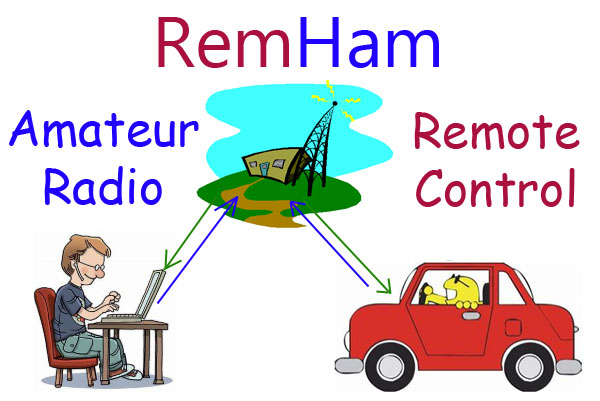Remham Information
Home
Configuring the RemHam Server
Configuring the RemHam Client

Technical Support
|
.
|
.

Configuring the RemHam Client
This page is under construction, but is hopefully reasonably complete!
How you configure your RemHam client will, to some degree, depend on how you
are using it.
Transmit/Receive Control
Transmit/Receive is typically handled in one of the following ways:
- Use the mouse or touch screen
- Configure an external Transmit/Receive switch
- VOX control
Mouse Transmit/Receive If you plan on using the mouse or a touch screen to click the "Transmit" button,
you will not need to configure any sort of hardware interface for T/R. You will
simply use the mouse or touch screen as the interface.
External T/R Switch or PTT If you use an external Transmit/Receive switch with RemHam, you will need to
use a COM port connected to a switch or interface. Documentation is provided
later in this section on various simple hardware interfaces.
VOX control Using VOX can be an effective T/R method
IF THE DIFFERENCE BETWEEN NO AUDIO (Mic disabled or off) and MIC ON (Audio
from the Mic) IS SUFFICIENT.
Mic preamps and other audio circuits typically produce a degree of background noise.
While this noise may not be significant, if the difference between "quiet" and "off" is not particularly great,
false VOX triggers (or drop outs) will occur.
The VOX trigger level and VOX slient time (delay) are configurable in Input Device settings. The VOX level is displayed on the RemHam client display when VOX is used.
Connecting to the server - Adding a remote server entry and configuration
To add a remote RemHam server entry, use the "File" and select "Setup or Connect to RemHam Server..."
If no servers have been configured, the only entry available in the server list
will be (Add Server). Choose this if not already selected, and click "Add/Edit". The Remote Server dialog box will appear.
Enter the required information about the remote server, and click OK when complete.
Configuration Options
RemHam offers quite a few settings that allow the user to configure RemHam
to match the user prefences and the specific hardware and other factors.
Settings:
Access most of RemHam's settings using the "Settings" menu. The following settings are available, with descriptions of what the setting does:
- Auto Reconnect After Network Error This will cause RemHam, once connected to a remote RemHam Server, to automatically reconnect to the server in the event of a disconnect or network error.
- Use Data Compression (Uses MUCH less bandwidth) This setting enables data compression. Saves quite a bit of network bandwidth, and for most practical purposes, there is little loss of fidelity. This option is typically used when using a poor (or variable) network connection such as might be found if using a phone as a hotspot for a laptop, etc.
- Server Sends Monitor Audio to Client when Server is Transmitting (Full Duplex Audio) When enabled, audio fed to the Server's input device will be sent to the RemHam Client, and sent to the Client's audio output device. Metering of the audio is also displayed.
This is full duplex audio. Only use this option if true, full duplex audio is needed.
- Server Sends Monitor Status (Monitoring/Metering only) to Client When Transmitting (Much Less Bandwidth) When enabled, the server sends audio status (meter indications only) to the RemHam Client. This is used when the server audio input device is connected to a modulation monitor or other such device when the server is in transmit mode. This is VERY useful in knowing that the transmitter is functioning properly, when you are running remote control.
- Enable Server Monitor Silence Alerts If you have configured the RemHam server such that audio is fed to the server's audio input device when transmitting (usually a modulation monitor), this setting enables audio alerts (beeps) if server monitor stops receiving audio (transmitter shuts down, etc.). Note: The server end must be configured such that audio from a monitor is fed to the server's input device when the transmitter is operating.
- Set Server Monitor Threshold Level Sets the audio threshold for the above setting, below which (after a few seconds) the client will alert the user.
- Transmit Button Emulates Push-To-Talk When selected, you must hold the mouse button down when transmitting. Otherwise, the Transmit button is a toggle (click to transmit, click to receive)
- Delay Mic until Receive Audio is Finished When selected, RemHam will play all buffered audio packets before RemHam transitions to transmit mode.
- Choose Input Device... Used to select the audio input device and configure the device for use by RemHam.
- Choose Output Device... Used to select the audio output device for use by RemHam.
- Choose Com Port... If extrenal transmit/receive control is used, selects the com port to be used. Usually this is connected to a switch or PTT mic, etc.
- Set Network Buffer Level... Sets the number of network buffers. Normally 10 is used.
View
- Always On Top Keeps RemHam in front of all other application windows
- Minimal View Reduces the RemHam window to a small size.
Using an External PTT Switch
If Transmit/Receive control using a switch or PTT is desired, the circuit shown below is one way to do it.
If you use the mouse for transmit/receive, you will not need to build any external circuitry.
Here is the Client side RS232 to PTT interface circuit I use with RemHam from the car.

|
|


